Chapter: 11th Accountancy : Chapter 13 : Final Accounts of Sole Proprietors-II
Adjustment entries and accounting treatment of adjustments
Adjustment entries and accounting
treatment of adjustments
1. Meaning of adjustment entries
Adjustment entries are the journal entries made at the end of the
accounting period to account for items which are omitted in trial balance and
to make adjustments for outstanding and prepaid expenses and revenues accrued
and received in advance.
2. Purpose of adjustment entries
The main purpose of adjustment entries are to match current year revenue
with the expenses incurred to earn these revenues. Other purposes are:
i.
To
exhibit true and fair view of profitability
ii.
To
exhibit true and fair view of financial status.
3. Need for adjustment entries
The need arises to pass adjusting entries for the following reasons:
i.
To record
omissions in trial balance such as closing stock, interest on capital, interest
on drawings, etc.
ii.
To bring
into account outstanding and prepaid expenses.
iii.
To bring
into account income accrued and received in advance.
iv.
To create
reserves and provisions.
4. Adjustments and adjustment entries
The following are the common adjustments and adjustment entries which
are made while preparing the final accounts.
i.
Closing
stock
ii.
Outstanding
expenses
iii.
Prepaid
expenses
iv.
Accrued
income
v.
Income
received in advance
vi.
Interest
on capital
vii.
Interest
on drawings
viii.
Interest
on loan
ix.
Interest
on investment
x.
Depreciation
xi.
Bad debts
xii.
Provision
for bad and doubtful debts
xiii.
Provision
for discount on debtors
xiv.
Income
tax paid
xv. Manager’s commission
(i) Closing stock
The unsold goods in the business
at the end of the accounting period are termed as closing stock. As per AS-2
(Revised), the stock is valued at cost price or net realisable value, whichever
is lower.

Presentation in final accounts

Tutorial note
Closing stock is the opening stock for the next accounting period. At
the beginning of the next accounting period this entry is reversed to bring
into account the opening stock.
Example
The value of closing stock shown as adjustment on 31st March, 2016 is Rs. 10,000. The adjusting
entry is:
Adjusting entry

In final accounts, it is presented
as follows:

Tutorial note
If closing stock is already
adjusted, adjusted purchases account and closing stock will appear in trial
balance. Adjusted purchases account will be shown on the debit side of the
trading account and closing stock will be shown on the assets side of the
balance sheet.
(ii) Outstanding expenses
Expenses which have been incurred in the accounting period but not paid
till the end of the accounting period are called outstanding expenses. In other
words, if certain benefits or services are received during the year but payment
is not made for the services received and utilised, these are termed as
outstanding expenses. Outstanding expense account is a representative personal
account and expense account is a nominal account.

Presentation in final accounts

Tutorial note
· If outstanding expenses account appears in the trial balance with credit balance, it means that journal entry has been made already for outstanding expenses. Hence, the outstanding expenses account will be shown only in the liabilities side of balance sheet. No adjustment is therefore necessary in expenses account as already expenses would have been adjusted.
·
At the beginning of the next accounting period the
above entry is reversed to bring into account outstanding expenses at the
beginning so that it is reduced from amount of expense of next year.
Example
For the year 2017, rent is payable @ Rs. 2,000 p.m. and during the year Rs. 20,000 is paid on
account of rent.
Total rent for the year 2017 is Rs. 24,000 i.e., 2,000 p.m. x 12 months. The difference between total rent
payable and actual rent paid Rs. 4,000 (
i.e. Rs. 24,000 - Rs. 20,000)
is outstanding rent. The adjusting entry is:


(iii) Prepaid Expenses
Prepaid expenses refer to any
expense or portion of expense paid in the current accounting year but the
benefit or services of which will be received in the next accounting period.
They are also called as unexpired expenses. Though these expenses are paid in
the accounting period, they are not incurred during the accounting period.
Prepaid expense account is a representative personal account. Expense account
is a nominal account.

Presentation in final accounts

Tutorial note
·
If prepaid expense already appears in trial balance
it means that it is already adjusted and journal entry has already been made.
Hence, prepaid expense is shown only in balance sheet.
·
At the beginning of the next accounting period, the
above entry is reversed to bring into account prepaid expenses at the beginning
so that it is added to amount of expense of next year.
Example
Insurance premium of Rs. 6,000 for one year is paid on 1st January, 2016
and the accounting year closes on 31st March, 2016.
In this example, insurance premium has been paid in advance or prepaid
for nine months, i.e.from 1st April to 31st December amounting to Rs. 4,500 (i.e., Rs. 6000 × 9/12). The
adjusting entry is:


(iv) Accrued income
Accrued income is income or portion of income which has been earned
during the current accounting year but not received till the end of that
accounting year. It generally happens in case of amount to be received on
account of commission, interest, dividend, etc.

Presentation in final accounts

Tutorial note
·
If accrued income account appears in the trial
balance with debit balance, it means that journal entry has been made already
for accrued income. Hence, the accrued income account will be shown only in the
assets side of balance sheet. No adjustment is necessary in income account as
already it would have been adjusted.
·
At the beginning of the next accounting period, the
above entry is reversed to bring into account accrued income at the beginning,
so that it is reduced from amount of income in the next year.
Example
A business has a fixed deposit of Rs. 1,00,000 with a bank for 12 months in the
accounting period ending 31st March, 2018 @ 9% interest p.a. Interest received
during the year was Rs. 6,750.
In this example, income earned is Rs. 9,000 (i.e., 1,00,000 × 9%). Income received is Rs. 6,750.Hence, the income
earned but not received, is the accrued interest ie., Rs. 2,250 (9,000 - 6,750).
The adjusting entry is:


v. Income received in advance
Income received in advance refers to income or portion of income
received in an accounting year which is not earned in the accounting period. It
is also known as unearned income or unexpired income. Though the amount is
received in the current accounting year, the benefit is yet to be offered to
the concerned person in the next accounting year.


Tutorial note
·
If income received in advance account appears in
the trial balance with credit balance, it means that journal entry has been
made already for income received in advance. Hence, the income received in
advance account will be shown only in the liabilities side of balance sheet. No
adjustment is necessary in income account as already it would have been
adjusted.
·
At the beginning of the next accounting period, the
above entry is reversed to bring into account income received in advance at the
beginning, so that it is added to the amount of income in the next year.![]()
Example
The trial balance as on 31st March, 2017 shows commission received as Rs. 7,500.
Adjustment: One-third of the commission received is in respect of work
to be done in the next accounting year.
Commission received includes one-third of the commission for the next
accounting period.Rs. 7,500 × 1/3,
that is Rs. 2,500 is
received in advance. The adjusting entry is:

In final accounts, it is presented as follows:

(vi) Interest on capital
According to separate entity
concept business and proprietor are two separate entities. Capital contributed
by proprietor is a liability to the business. Hence, interest may be provided
on capital contributed by proprietor. It is treated as a business expense. The
purpose is to know the true profit of the business.
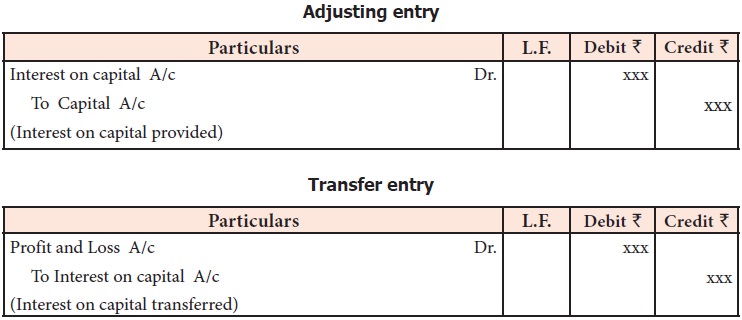
Presentation in final accounts

Tutorial note
Interest on capital is calculated
on the opening balance of capital if there is no change in the capital account
during the accounting year. If there is any additional capital introduced or
capital withdrawn, then interest on capital is to be calculated proportionately
on the balance outstanding.
Example
The trial balance prepared on
31st December, 2016 shows Capital of Rs. 5,00,000.
Adjustment: Provide interest on
capital @ 4% p.a.
Interest on capital = Rs. 5,00,000 × 4/100 = Rs. 20,000.
The adjusting entry is:

In final accounts, it is presented as follows:

(vii) Interest on drawings
Drawings represent the amount or goods withdrawn by the proprietor from
the business for his personal use. As business is separate from owner, interest
charged on drawings, if any, is to be treated as business income.


Presentation in final accounts

Example
The trial balance on 31st March,
2016 shows capital as Rs. 1,50,000
and drawings as Rs. 10,000.
Adjustment: Charge interest on
drawings at 4%.
Interest on drawings = Rs. 10,000 × 4/100 = Rs. 400. The
adjusting entry is:
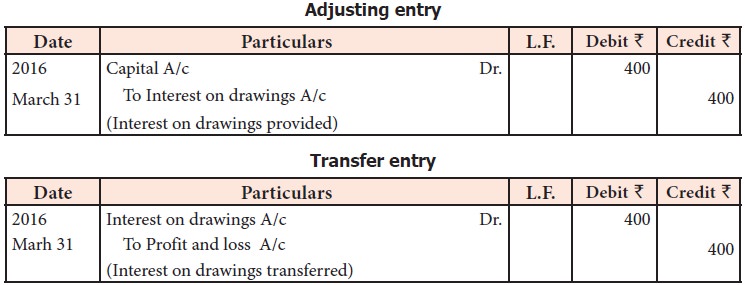
In final accounts, it is presented as follows:

(viii) Interest on loan
Business entities may have loans
borrowed from banks and other financial institutions, private money lenders,
etc. If any interest is payable on loan and not yet provided at the time of
preparation of trial balance, it is necessary to provide for outstanding
interest on loan. It is an outstanding expense.

Presentation in final accounts

Tutorial note
·
If the trial balance contains loan account
specifying the percentage of interest and date of borrowing and interest paid
appears in the trial balance, it is to be checked whether interest for the
whole year is paid. If it is not paid, outstanding interest must be adjusted.
·
Similar to any other expenses outstanding, this
entry also will be reversed at the beginning of the next accounting period.
Example
Extracts from the trial balance
as on 31st December, 2017 is given below:

Adjustment: Interest on loan is unpaid for three months.
Interest unpaid = Rs. 5,00,000 × 12/100 × 3/12 = Rs. 15,000. The adjusting entry is:

In final accounts, it is presented as follows:


(ix) Interest on investment
Business entities may have
investments in outside securities carrying specified rate of interest. If
interest is due but not yet received, adjustment is to be made for the same in
the accounting records before preparation of final accounts. Interest
receivable on any investments in the form of shares, deposits, etc. made
outside the business is called accrued interest. It is an accrued income.

Presentation in final accounts

Example
Extracts from the trial balance as on 31st December, 2017 is given below:


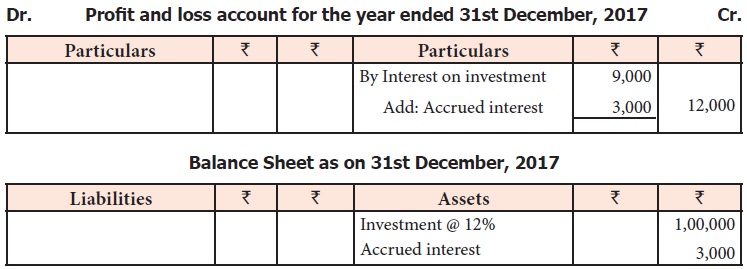
(x) Depreciation
The decrease in book value of fixed assets due to usage or passage of
time is called depreciation. It is a loss to the business. Therefore, it must
be written off from the value of asset. Generally, a certain percentage on the
value of the asset is calculated as the amount of depreciation.
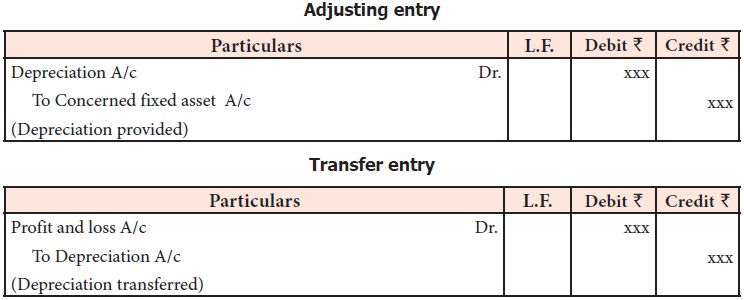
Presentation in final accounts

Tutorial note
When depreciation already appears in trial balance, it means journal
entry is already made and asset account has been already reduced to the extent
of depreciation. Hence, depreciation will be shown only in profit and loss
account.
Example
The trial balance prepared on
31st March, 2016 shows the value of buildings as Rs. 50,000.
Adjustment: Depreciate buildings
@ 10% p.a.
Amount of depreciation = Rs. 50,000 x 10/100 = Rs. 5,000.
The adjusting entry is:
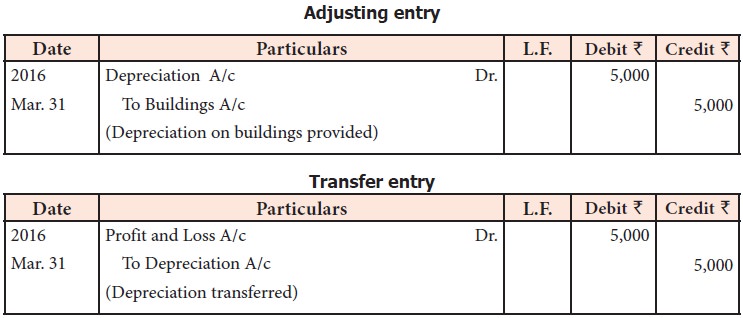
In final accounts, it is presented as follows:
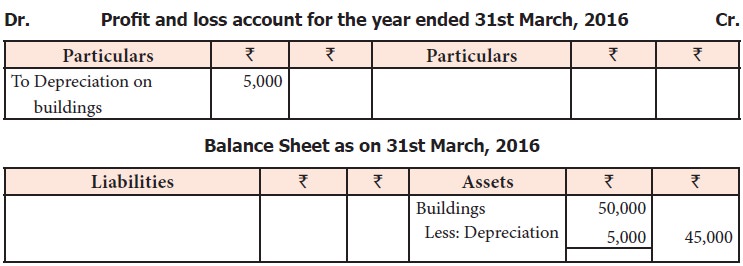
(xi) Bad debts
When it is definitely known that
amount due from a customer (debtor) to whom goods were sold on credit, cannot
be realised at all, it is treated as bad debts. In other words, debts which
cannot be recovered or irrecoverable debts are called bad debts. It is a loss
for the business and should be charged against profit.
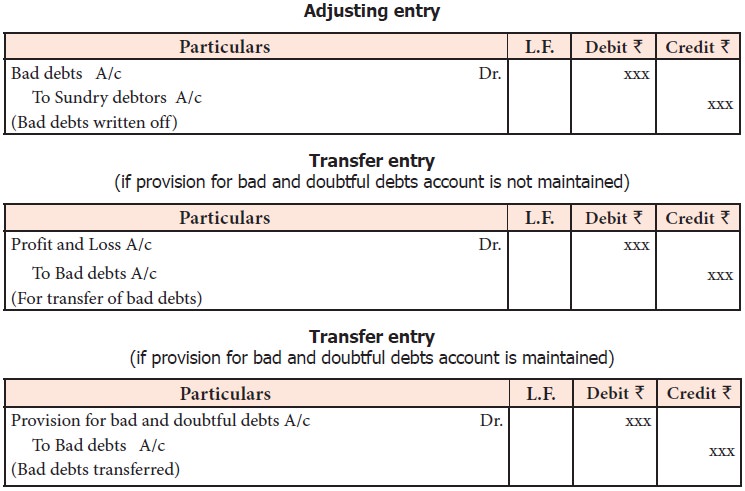
Presentation in final accounts

Tutorial note
·
When bad debts already appears in the trial balance
it means journal entry is already made, i.e., debtors is already reduced.
Hence, bad debt is taken only to debit side of profit and loss account.
·
If there is bad debt in trial balance as well as in
adjustments, total bad debt is debited in profit and loss account. Additional
bad debt only is deducted from debtors in the balance sheet.
Example
The trial balance as on 31st
December, 2016 shows sundry debtors as Rs. 1,02,000.
Adjustment: Write off Rs. 2,000 as bad debts. The adjusting entry is:


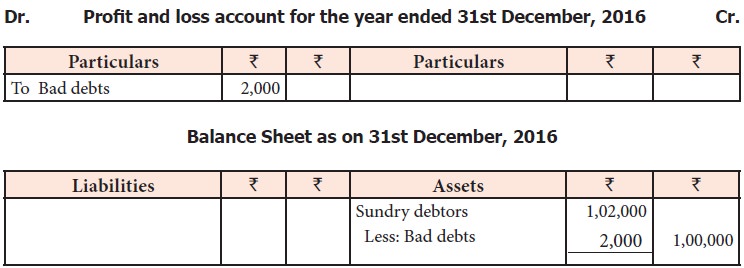
(xii) Provision for bad and doubtful debts
Provision for bad and doubtful debts refers to amount set aside as a
charge against profit to meet any loss arising due to bad debt in future. At
the end of the accounting period, there may be certain debts which are
doubtful, i.e., the amount to be received from debtors may or may not be
received. The reason may be incapacity to pay the amount or deceit.![]()
In general, based on past experience, the amount of doubtful debts is
calculated on the basis of some percentage on debtors at the end of the
accounting period after deducting further bad debts (if any). Since the amount of
loss is impossible to ascertain until it is proved bad, doubtful debts are
charged against profit and loss account in the form of provision. A provision
for doubtful debts is created and is charged to profit and loss account. When
bad debts occur, it is transferred to provision for doubtful debts account and
not to profit and loss account.
This is according to the
convention of conservatism. Moreover, according to matching principle, all
costs related to earning revenue in a period must be charged in the relevant
period itself. Hence, it is appropriate that provision is created in the
current year against debtors of current year.

Presentation in final accounts

Example
The trial balance prepared on 31st
December, 2016 shows sundry debtors as Rs. 1,50,000.
Adjustment: Provide 5% for bad
and doubtful debts on sundry debtors.
Provision for bad and doubtful debts = Rs. 1,50,000 x 5/100 = Rs. 7,500. The adjusting entry is:

In final accounts, it is presented as follows:
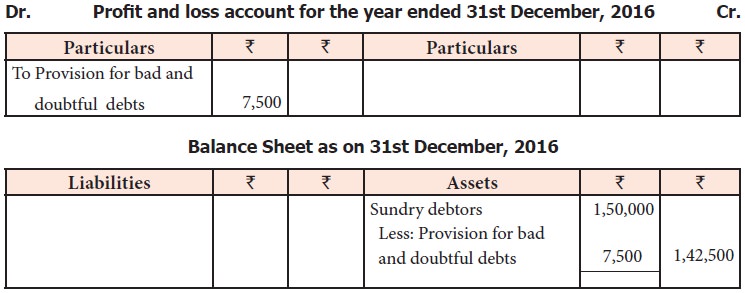
Tutorial note
When provision already exists and
appears in trial balance, the accounting treatment is as below:
·
If the provision required at the end plus the bad
debts written off, is higher than the existing provision, the difference amount
will be created as provision in the current year and will appear on the debit
side of profit and loss account.
·
If the provision required at the end plus bad debts
written off, is lesser than the existing provision, the excess is written back
and will appear on the credit side of profit and loss account.
The journal entries are:
(a) For bad debts written off
Bad debts A/c Dr. xxx
To Debtors A/c xxx
(b) For transferring bad debts
Provision for doubtful debts A/c Dr. xxx
To Bad debts A/c xxx
(c) For creating provision to the extent of difference
Profit and Loss A/c Dr. xxx
To Provision for doubtful debts A/c xxx
(d) For writing back provision to the extent of difference
Provision for doubtful debts A/c Dr. xxx
To Profit and Loss A/c xxx
(xiii) Provision for discount on debtors
Cash discount is allowed by the suppliers to customers for prompt
payment of amount due either on or before the due date. A provision created on
sundry debtors for allowing such discount is called provision for discount on
debtors. This provision is a charge against profit and hence profit and loss
account is debited.
Provision for discount on debtors
is made on the basis of past experience at an estimated rate on sundry debtors.
Discount should be calculated on sundry debtors after deducting bad debts and
provision for bad debts.

Presentation in final accounts

Tutorial note
i.
Provision for discount on debtors is calculated on
the balance of debtors after deducting bad debts and provision for doubtful
debts. This is because provision for discount is to be expected only on good
book debts. When the amount realisable itself is doubtful, provision for
discount is not to be made. Similar to bad debts and provision for doubtful
debts, here also discount allowed to debtors must be transferred to provision
for discount on debtors account if a provision exists.
ii.
When provision already exists and appears in trial
balance, the accounting treatment is as below:
·
If the provision required at the end plus the
discount allowed, is higher than the existing provision, the difference amount
will be created as provision in the current year and will appear on the debit
side of profit and loss account.
·
If the provision required at the end plus discount
allowed, is lesser than the existing provision, the excess is written back and
will appear on the credit side of profit and loss account.
The presentation in the balance
sheet is as below:
Debtors xxx
Less Bad debts (in adjustments) xxx
Less Provision for doubtful debts (end) (adjustment) xxx/xxx
Less Provision for discount on debtors (end) (adjustment) xxx/xxx
Balance to be shown in balance sheet xxx
Example
The trial balance for the year
ended 31st March, 2016 shows sundry debtors as Rs. 50,000.
Adjustment: Create a provision
for discount on debtors @ 1%.
Provision for discount on debtors
= Rs. 50,000 x 1/100 = Rs. 500. The
adjusting entry is:

In final accounts, it is presented as follows:

(xiv) Income tax paid
As per the Indian Income Tax Act,
1961, business income of the sole proprietor is not assessed and taxed
separately. It is the sole proprietor who is assessed to tax for his total
income including the business income. Hence, income tax paid by the business is
not a business expenditure and is treated as drawings.

Presentation in final accounts

Example
Trial balance of Sibi as on 31st December, 2017 shows the capital as Rs. 1,05,000 and cash at bank as Rs. 80,000.
Adjustment: Income tax paid Rs. 15,000. The adjusting entry is:


(xv) Manager’s commission
Sometimes the manager is given
commission as a percentage on profit of the business. It may be given at a
certain percentage on the net profit before charging such commission or after
charging such commission. Calculation procedure is explained below:x


The purpose of giving such
commission may be to motivate the managers to work with their full potential,
to reward the managers for their efficiency and to retain the efficient
managers by rewarding them sufficiently. Such commission can be calculated only
at the end of the accounting period after calculating net profit. Hence, it
remains outstanding at the end of the accounting period.
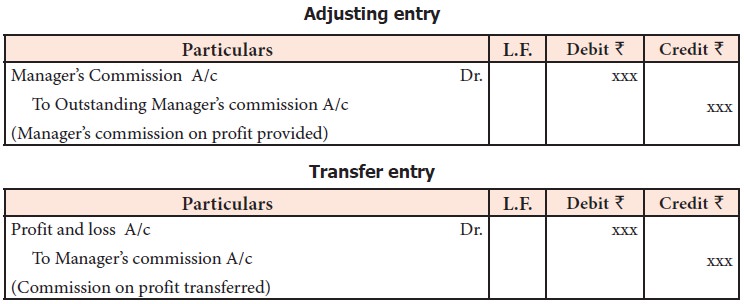
Presentation in final accounts

Example
On 31st March, 2017, Net profit
before charging commission is Rs. 11,000.
The manager is entitled to
receive 10% as commission on the profit before charging such a commission.
Commission = 11,000 x 10/100 = Rs. 1,100. The adjusting entry is:
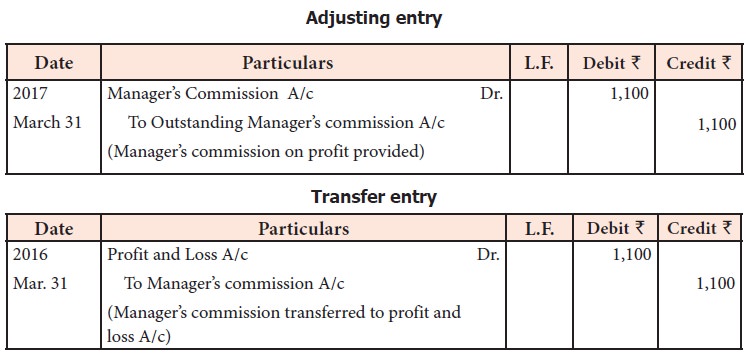
In final accounts, it is presented as follows:


Example
On 31st March, 2017, Net profit
before charging commission is Rs. 11,000.
Adjustment: Provide manager’s
commission at 10% on the profit after charging such Manager’s commission.



Related Topics